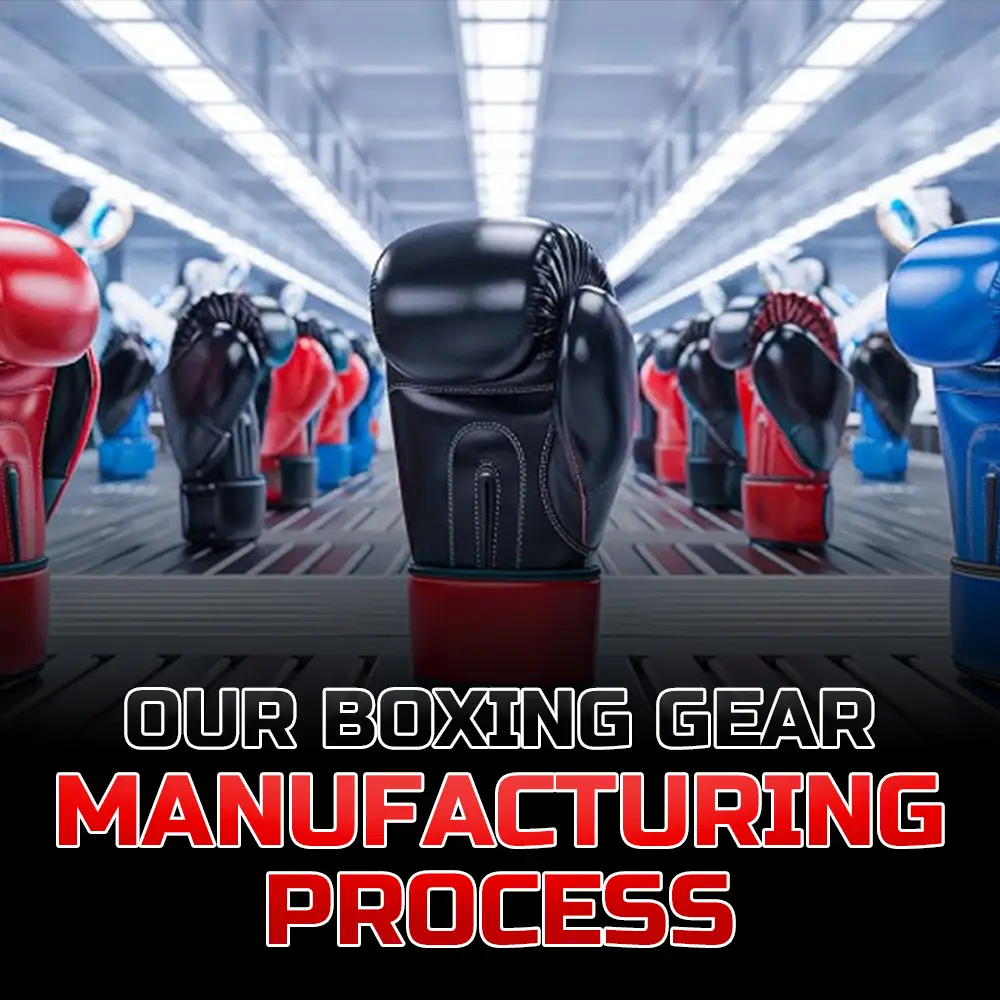Have you heard the interesting story about our boxing gear manufacturing process? Many companies say they have a unique process, but the basic goal is the same. Creating useful and strong gear for you.
Finding the right wholesale boxing gear for you may feel hard. But no problem, we want to make it easy. With the Fortstitch production story, you will see every step. From design and color to the final, our product has everything you can trust.
The Process of Making Leather Gloves
So, how hard is it to make customized leather boxing gloves and other gear? Different companies use various methods, starting from basic design to finished gear. With unique production, they turn raw materials into reliable and useful gloves. This process turns equipment into the color and style of your choice. Let’s take a close look at how it’s made.
Steps of Our Boxing Gear Manufacturing Process
1. Material Selection
The process of making boxing gloves starts with the careful selection of materials. Fighting gear needs qualities like resilience and flexibility. This is a must for safety and speed of movement. Leather is a primary choice due to its durability, hardness, and elasticity. The ability to mold to the shape you need and the wearer’s hand gives a custom fit. We choose the best materials to keep you safe and strong. Here are the most common and best types of leather we use for our wholesale fighting gear.
| Type of Leather | Why It’s Great for Fighting Gear? | Best For Whom? |
| Cowhide Leather | Very strong and has great durability. It can take a lot of impact. | Fighters who want long-lasting gloves for daily training. |
| Buffalo Leather | Even tougher than cowhide! It has a rough feel and amazing hardiness. | Heavy bag work and intense training sessions. |
| Goatskin Leather | Super flexible and soft. It molds to your hand over time for a perfect fit. | All-around training and sparring where comfort is key. |
| Synthetic Leather (PU/Vinyl) | A strong man-made option. It is easy to clean and very consistent. | Beginners, fitness boxers, and anyone looking for a great value. |
This same careful selection process is used for all our products, including our MMA Gloves for Boxing, so every fighter gets the perfect gear.
2. The Design of Wholesale Boxing Equipment
The design of boxing gear is a smart science. Padding is the most important part. A special foamy substance that absorbs energy is used. It compresses to catch the force. The padding thickness is made by adding or removing layers as per weight classes.
Fighters wear gloves of different weights. Heavy boxers need more protection, whereas strikes from lightweight boxers need less. Safety in design is a must. The thumb comes with the glove’s base. This protects boxers from elbowing each other. Also, knuckle regions are white for scoring purposes, so punches are visible.
This smart thinking covers all our customized boxing equipment, including hanging punching bags.
From gloves to bags, we build gear that defines strength.
Explore our boxing equipment collection today.
3. Cutting and Stitching of Gloves
Now the process starts when we turn flat leather into the shape of the glove.
a. Cutting Phase
First, with special patterns, we decide the size for different parts like the palm and thumb. Then, craftsmen cut the leather into panels with precision. This step makes sure each piece fits together. This is the key to the outer shell.
b. Sewing Phase
Our artisans sew the panels with high-quality threads. We use double stitching to reinforce critical areas. This increases the durability of the boxing gloves. Every stitch is proper for more strength and longevity. A high-quality glove withstands the hardness of training.
Ready for gloves made with this level of care for your gym or active wear line? Contact us today for a free quote!
4. Padding and Assembly
Boxing gloves’ padding is very important for their design. It protects the boxer’s hand and ensures the opponent has safety from injuries. For this, new padding material, or injection moulded foam, or PVC foam, is used. This has a good level of comfort and rate of impact absorption.
This padding is placed into the glove’s shell properly. Different weights are used for different fighters’ needs. Some gloves have extra padding for knuckles or the wrist for more protection. While some have lightweight construction for more speed.
The foam inside your gloves is their heart. Different padding types are best for different kinds of training. Here’s a simple guide to help you choose.
| Padding Type | Best For This Weight | Best Training Category | Why It’s Good? |
| Multi-Layer Foam | 12 oz – 16 oz | All-Around Training & Sparring | Perfect balance of impact absorption and comfort. Protects your hands and your partner. |
| Injection Moulded Foam (IMF) | 10 oz – 14 oz | Bag Work & Pad Work | Gives a firm, compact layer for great feedback and hitting power on the bag. |
| Latex or PVC Foam | 8 oz – 10 oz | Competition & Speed | A lightweight construction that allows for increased speed and agility. |
| High-Density Horsehair | 10 oz – 12 oz | Professional Sparring | A traditional feel that is firm and contributes to stiffness, used by experienced fighters. |
5. Shaping and Forming of Fighter Gloves
After the padding is done, the process for special shaping and forming starts. This step gives them their final structure.
We use a gentle heating process to soften the materials. This allows us to mold them into the shape of a fist. The final touch is to give it a shape of hand shape, to give a fine fit. This creates a proper design that matches the shape of your hand.
You will get this same shaping expertise in our speed balls, with perfect control and comfort.
6. Finishing Process
The final steps of manufacturing boxing gloves include touches that improve both their shape and working.
This includes attaching strong velcro straps or laces for a secure closure. We also focus on embroidering your logos and designs onto the glove’s top. Lastly, it is finished by applying any additional reinforcement or padding as needed to make them perfect.
Just like our supportive weightlifting belts, every detail is checked to ensure your gear is both tough and looks great.
7. Quality Control and Inspection
Every gear created passes through a strict quality check. This critical process ensures every pair meets the highest standards of performance and safety. Our team inspects each glove deeply to find defects or imperfections, if any. If there is any issue, it will be resolved immediately before we pack and ship them.
We treat our gloves with the same pride as our champion belts—because you deserve gear that is perfect, powerful, and safe.
Best Boxing Equipment for your brand
Launching a successful boxing brand demands more than just a logo; it requires equipment that builds trust. Your brand deserves gear that can make its name on quality. FortStitch manufactures boxing gloves that not only make a promise but deliver premium, durable leather, superior impact-absorbing foam, and expert hand-stitched craftsmanship in every pair.
We are sure our gears will make your name with excellence. Don’t just sell boxing gear; sell it with confidence. Partner with FortStitch today and let us craft a gear that will become your identity.
Conclusion
Whether it’s boxing gear or gym accessories, safety is top priority. It must pass a series of steps before the final check. This process makes sure every piece is according to the highest standards. We inspect each glove to identify any defects. If there is any issue, we fix it right away. We pack and ship a glove only if it is perfect.
Every detail is chosen for your success. Ready to gear up? Contact us now for your custom quote!
FAQs
Q1. How are boxing gloves manufactured?
They are made by cutting and stitching strong leather panels, inserting protective foam padding, shaping the glove on a mold, and adding straps or laces after a final quality check
Q2. How long does it take to make a boxing glove?
The entire process, from cutting the material to the final inspection, can take several hours for a single pair due to the detailed, skilled work involved.
Q3. How to start your own boxing brand?
Start by finding a reliable manufacturer, designing your unique gear, and building a brand story. Then, plan your sales online and to local gyms to get started.
Q4. Are boxing gloves made of horse hair?
Some professional gloves still use horsehair for a firmer feel, but most modern training gloves use high-density foam for better safety and impact absorption.
Q5. What material is used for boxing gloves?
Common materials are genuine leather, like cowhide or goatskin, for durability, and synthetic leather (PU) or vinyl for affordable, high-quality training gloves.

